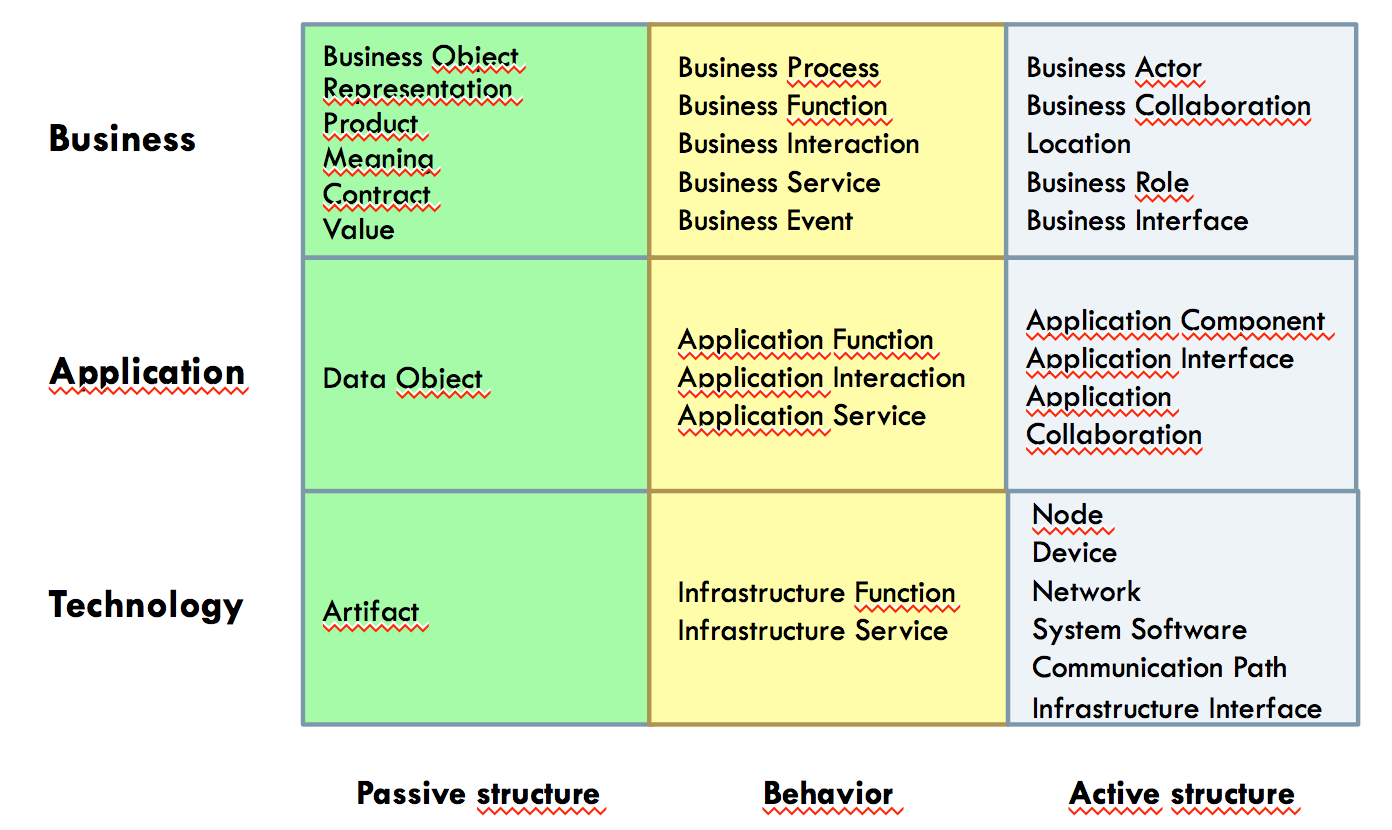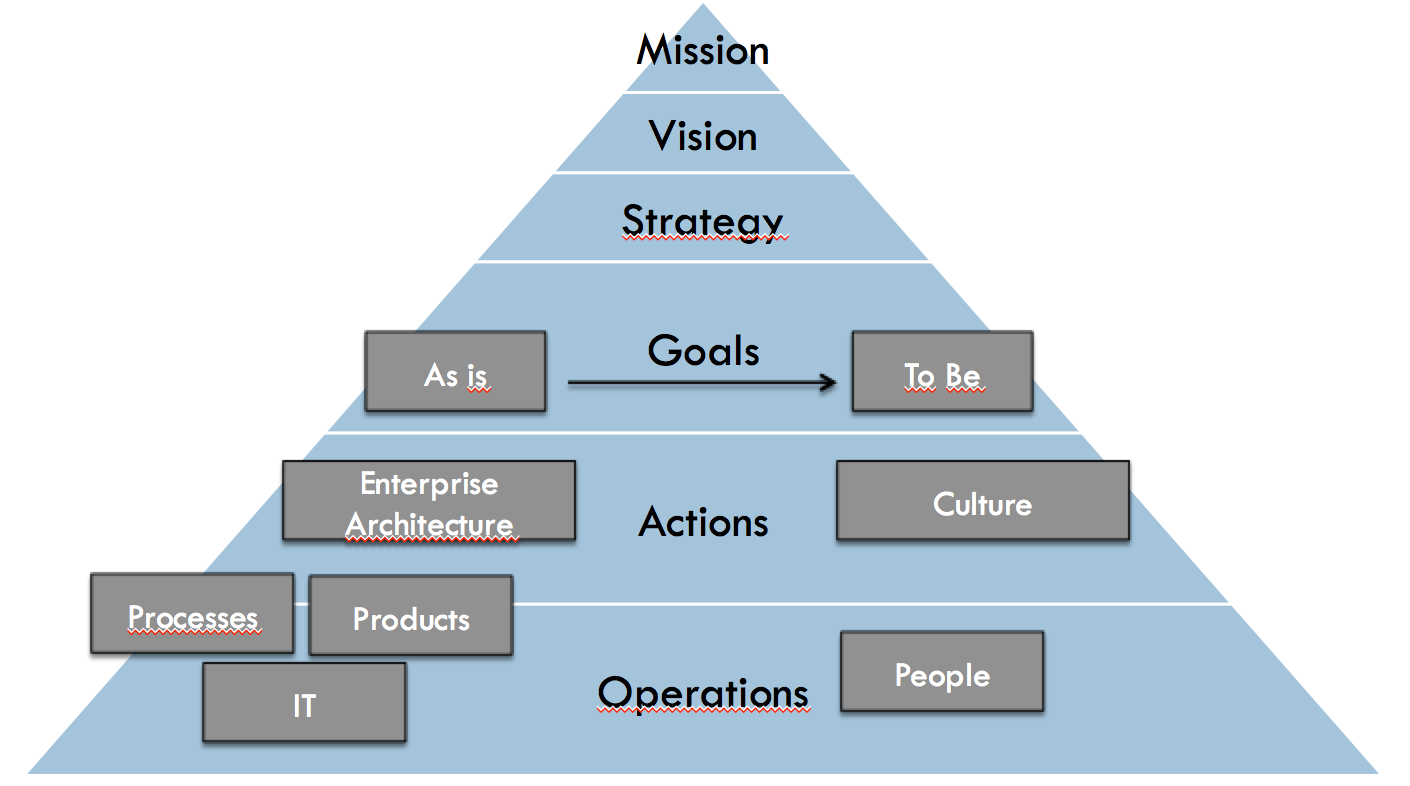How do you communicate changes in your business processes, application landscape or IT infrastructure to senior management and other stakeholders? I advocate ArchiMate as a common modelling language which can be applied easily by both business and IT. Last week I gave a training on this language for a client in Brussels. My three reasons why I think ArchiMate´s adding great value…
ArchiMate is a modelling language developed and cared for by The Open Group. It´s supporting all kinds of modelling tasks accumulating in Enterprise Architecture (EA) Management. Using ArchiMate you can create models of your company´s business processes, application landscape and IT infrastructure.
The ArchiMate framework (see picture) consists of three layers: bu siness, applications and infrastructure. On each layer the language provides symbols in three categories:
siness, applications and infrastructure. On each layer the language provides symbols in three categories:
- Active structure concepts such as business roles and actors, application components or infrastructure devices represent your company´s layout and structure.
- Behavioral concepts such as business processes, application functions and interfaces or infrastructure functions describe what your active structure concepts are „doing“.
- Passive structure concepts such as contracts and products, data objects and infrastructure artifacts represent the items your company is working with, using, producing, etc.
ArchiMate connects the three layers using a service-oriented concept. Furthermore it offers different views on the Enterprise Architecture suited for stakeholders such as IT architects, software engineers or project managers.
Value 1:ArchiMate facilitates communication between business and IT
Enterprise Architecture Management is a communication and learning process. It´s about analysing existing architectures, deciding about future changes, planning transitions and migrations or instructing software development teams, hence communication processes.Quality and velocity of these processes depend on a number of factors, of which explaining and linking knowledge plays a key role. In EA only explicit knowledge can be created, furthered and disseminated – you simply can´t learn about your company´s architecture the same way you learned riding a bike (which is learning implicit knowledge through a social process).
ArchiMate supports you in improving your knowledge´s explicitness in five dimensions:
- Formality: ArchiMate offers well-defined and easy-to-learn semantics which gives the user a lot of freedom
- Quantifiability: With ArchiMate you can express resource usages, capacity constraints, time lines and other quantifiable EA aspects.
- Executability: Using ArchiMate you can create models that can be implemented right away because it describes organizational behavior.
- Comprehensibility: ArchiMate´s graphical notation is very easy to understand and aims to convey „narratives“ about EA.
- Completeness: ArchiMate aims to be as general as possible and as specialized as possible through its very lean notation system.
Value 2: ArchiMate drives stakeholder-orientation
Many IT departments struggle in gathering and defining requirements with the business. Representatives from business on the other hand struggle understanding IT and their specific abstract view of the world. Even within IT departments the understanding between senior management and techies is oftentimes limited.
Enterprise Architecture Management means to address a number of stakeholder´s concerns regarding the company and its business, applications and infrastructure. Stakeholders are key roles of an organization (regardless of internal or external) who have specific concerns which depend on their role. Each stakeholder has a specific view on the organization (e.g. an auditor is focussing on compliance aspects, not on network bandwidth).
ArchiMate, as a modelling language for Enterprise Architecture, offers viewpoints on the architecture for three specific purposes:
- Deciding: for stakeholders involved in decision-making such as CEOs, CIOs, etc.
- Informing: for stakeholders requiring information about current configurations and upcoming changes such as customers, end users, etc.
- Designing: for stakeholders involved in design, development and implementation projects such as architects, developers or business process designers
For each of these purposes the viewpoints can be grouped into three different categories:
- Overview: provides an overview for informing, deciding or designing purposes over multiple architecture layers
- Coherence: provides a coherent view over multiple layers and aspects focussing on informing, deciding or designing dependencies and impacts of changes
- Detail: concentrate on one architecture layer and single aspects
With its explicit viewpoint mechanism ArchiMate offers architects a tool to focus on stakeholders´specific concerns and address them purpose-specific.
Value 3: ArchiMate supports implementing company strategy
Most companies know how to create a strategy. They define missions, visions and strategic goals. Some companies even manage to define specific and measurable strategic goals. Difficulties arise in transforming these goals into operational reality since it requires changing a company´s culture, processes and products.
While changing culture is a soft factor of strategy implementation, Enterprise Architecture is basically about the hard factors of strategy. It means to decide about, design and redesign business processes, products and IT in order to maximize alignment to company strategy.
ArchiMate offers a graphical notation and useful semantics to describe and develop changes in the company´s „hardware“. Its cross-layer relationship model allows to trace changes in IT infrastructure back to the strategic level. Its motivation extension aims to identify stakeholders and their different goals, principles, assessments and drivers. And last but not least the implementation & migration offers a notation to design architecture changes and define work packages and deliverables for projects and programmes alike.
In this sense ArchiMate is a coherent and extremely accessible tool for strategy implementation, stakeholder communication and Enterprise Architecture Management.
A decent training in ArchiMate takes about 2 to 3 days. The Open Group offers a two-step certification process and a complete range of literature and online learning material. A series of commendable books exists containing useful information about the language and its application.
